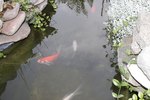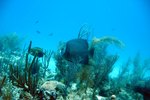Things You'll Need
Floating trout pellets
Agricultural lime or gypsum
Screen or grate
Aquatic plants
Sodium carbonate proxyhydrate
Rainbow trout are cold-water fish native to North American streams, rivers and lakes west of the Rocky mountains. These fish generally weigh about 8 lbs. and are blue green with a pink streak on their side. Rainbow trout are often kept in man-made and natural fish ponds and lakes. Since they are already accustomed to the North American environment, these trout are easy to care for in captivity and only need a few basic requirements to sustain them.
Keep a steady water flow through the fish pond or lake. Rainbow trout need a high level of oxygen of about 5 mg per liter of water, according to the Penn State College of Agricultural Sciences. A constant stream of water in and out of the fish pond will keep the water's oxygen level high.
Avoid overstocking the pond with too many trout. The more trout you have in your pond, the lower the level of oxygen in the water. Keep no more than 300 rainbow trout in an 8-foot-deep, 1-acre pond.
Provide additional food to supplement the trout's natural diet of insects and help the trout grow bigger. Feed the trout about 1 quart of floating trout pellets per 100 trout during the growing season, when the water is between 50 and 65 degrees Fahrenheit, about once a day.
Purchase sterile trout if you want your fish to live longer than 2 years. Rainbow trout typically live 5 years, but female rainbow trout sometimes die early when they cannot release their eggs. Sterile trout are more expensive but will live longer than nonsterile trout.
Clear muddy water caused by colloidal particles by applying agricultural lime, also known as calcium carbonate, to the water. Trout prefer clear water; apply about 1,000 pounds of agricultural lime or agricultural gypsum per surface acre of water to keep the water clear. Apply the lime or gypsum weekly until the water is clear.
Place a screen or grate over the exit stream in the pond to prevent trout from escaping. The trout may swim upstream in the entry stream to spawn but will return to the pond afterward.
Restock the pond every two to five years. How often you should restock the pond depends on whether you have sterile or nonsterile trout. Restocking the pond often will help maintain a healthy trout population.
Plant aquatic plants in the pond to give trout a protective refuge and hiding place. Aquatic plants such as lily pads, water shield and spatter dock also regulate the water temperature by protecting part of the water surface from the sun's direct rays.
Apply sodium carbonate proxyhydrate to the water to prevent algae blooms in the pond. Algae blooms can deplete oxygen levels in water and suffocate the trout. Apply about 8 to 25 pounds of sodium carbonate proxyhydrate per acre of water once a month.
References
- State of Washington Department of Ecology: Algae Control Methods
- Penn State College of Agricultural Sciences: Management of Fish Ponds in Pennsylvania
- Virginia Department of Health: What Are Harmful Algae Blooms?
- North Carolina State University: Care of Trout in Recreational Ponds During the Winter
- Hy-on-a-Hill Trout Farm: FAQ
Photo Credits
-
Digital Vision./Photodisc/Getty Images




